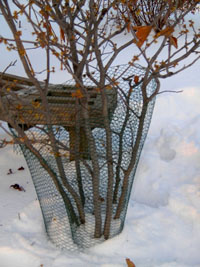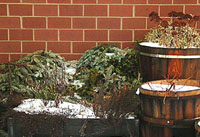
Wire mesh fencing shields woody plants from hungry rodents.
Even though my witch hazel and aromatic 'Raydon's Favorite' aster are still blooming, I know the gardening season is ending and it's time to take steps to help my outdoor plants make it through the winter. The time I take now can mean the difference between plant survival and loss come spring.
Even during the winter, mulch serves an important function in the garden. Although it's often called the garden's “blanket,” winter mulch is valuable not for keeping roots or soil warm, but rather for moderating temperature extremes. Midwinter freezing and thawing of the ground can kill roots (and subsequently plants) in the top few inches of soil. Mulch helps maintain a constant cool temperature, shielding the roots from the warmth of a bright January day and the bitter bite of a deep February night.
Wait to apply mulch until the soil temperature has dropped below 40 degrees F. Then add a 5- to 6-inch-thick layer around trees and shrubs, and a little less -- 3 to 4 inches -- in perennial beds. Christmas tree branches, wreaths, hay bales, and evergreen branches from holiday decorating can also be placed throughout the garden to cover the ground. You can shred them or leave them intact.
In the spring when temperatures are still cool, remove some mulch from your perennial bed to help the spring bloomers and bulbs emerge. St. Patrick's Day is typically the perfect time to remove extra mulch in northern zones.
Plants hardy in your zone when planted in the ground may not be hardy in an aboveground container. If you want to grow plants in containers outdoors year-round, choose plants that are at least a couple of zones hardier than your zone. For instance, Chicago is in USDA zone 5 (although rising temperatures are shifting us to zone 6), so all the perennials and shrubs in my containers need to be hardy to at least USDA zone 3. (See NGA's Hardiness Zone Finder.)

Evergreen boughs protect
outside planters from temperature extremes.
To help plants in containers survive the winter, place them in a sheltered spot away from bitterly cold, desiccating winds. Spread evergreen boughs (from the Christmas tree and decorations), leaf litter, or some other mulch on top of the containers to limit the thawing and freezing of the soil. Leave containers covered throughout winter.
Last year, mid-January temperatures were so mild that I removed the evergreen branches from my containers and hoped for an early spring. The soil thawed and bulbs began to sprout. Winter resurged with a vicious cold snap that froze the containers solid and killed scores of my emerging bulbs. Learn from my mistakes and don't be in too much of a hurry. Put your containers in a sheltered spot, cover them, and leave them until spring.
If the plants are marginally hardy or if exceptionally cold spells are expected, it's a good idea to wrap containers for extra protection. Use old blankets, insulation, tarps, and/or burlap, and stuff hay or straw between the pot and the covering. Or set hay bales around the container. Or set a container inside a larger one and stuff mulch into the space in between, leaving some air space. Remember: you are not trying to keep the container, plants, or soil warm, just protected from the extremes.
Shrubs and trees face a harsher winter than perennials. Although the roots are secure in the soil, the stems and branches suffer the full brunt of wind and cold. Protect marginally hardy deciduous shrubs, as well as evergreens that are prone to winter wind damage, with burlap and blankets, just like containers. First tie the branches up with twine to make wrapping easier.
Hybrid roses are especially sensitive to cold temperatures. Anyone who has grown hybrid tea roses knows that the rootstock is a different plant than the blooming wood. When you don't protect the graft point -- the swollen knot near the base of the central stem -- from winter freezes, a prized 'Rio Samba' or 'Peace' rose reverts to the dark pink, May-blooming, wild-growing rootstock. Not a terrible plant but definitely not the cultured rose you purchased. Cover the graft point by mounding bark chips, compost, straw, evergreen boughs, or other protective mulch around the stem. Rose cones help, too, however I don't like the looks of those white, tombstone-like coverings and suggest decorating them in a winter theme as a fun family holiday project.
Weather is not the only problem. Rabbits will feed on twigs and bark all winter. Any smooth-barked woody plant is susceptible, including crab apples, cotoneaster, azaleas, blueberries, redbuds, and even witch hazel. Wrap shrubs with chicken wire at least 30 inches tall to discourage rabbits. Voles and mice also feed on bark, but usually only if they nest against the trunk. It is important not to spread winter mulch around woody plants until it is cold, and even then don't pile it against the stems. You want the critters to have already made a winter home elsewhere before you create a cozy spot around your rose or pussy willow.
Mulching, winterizing containers, and protecting trees and shrubs are the final garden chores of the season for many of us. While our friends in San Diego and Tampa are planting veggies and harvesting grapefruits, the rest of us are curling up in blankets with some gardening catalogues and dreaming of the next season.
Related Articles: